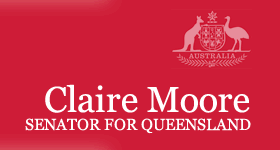Senator MOORE (Queensland) (10.17 pm)—
Heart Disease
Senator MOORE (Queensland) (10.17 pm)—On Friday, 12 June, the National Heart Foundation called upon women and men in our country to join together and be involved in a special campaign called Go Red for Women. It unites Australian women in the fight against the leading killer of women in our country: heart disease. It raises awareness about the risks and it helps women to make healthier choices. The Go Red campaign was instigated in America and, as they often do—they lead on these kinds of things—they have started a movement which has moved across the world. Now more than 33 countries participate in the Go Red for Women campaign, which is aimed at reducing cardiovascular disease in women by building global attention and commitment.
The three main objectives of the Go Red campaign are: firstly, to challenge the widely-held belief that heart disease is largely a disease for men; secondly, to encourage women to learn more about the risk factors associated with heart disease and to take real personal action to avoid them; and, thirdly, to raise much needed funds to assist the Heart Foundation to spread this message about heart disease and to be involved in the general support and research around heart issues. One of the most important things is to make sure that women understand that this disease is one that kills them. In fact, we found through surveys that women do not understand this. We know that, on average, heart disease kills about 204 Australian women per week.
Just think about that. About 30 women every day die from a condition that is linked to heart disease. Heart disease is responsible for 16 per cent of all deaths in Australian women. In 2007, 10,610 Australian women
died of heart disease. We actually learn much about all kinds of conditions in this country, and I know there have been marvellous campaigns around breast cancer; many people have spoken about that issue in this place. But, confrontingly, Australian women are four times more likely to die from heart disease than from breast cancer. And we know that women do not know these figures.
A Heart Foundation survey conducted in 2008 of 1,964 women aged between 30 and 65 living in Australia found that more than 78 per cent of these women were not aware that heart disease is the leading cause of death for their gender in Australia. Most women recognised that smoking causes danger. Poor diet and lack of exercise are also risk factors; however, almost two-thirds of the women surveyed did not identify that blood pressure, cholesterol or diabetes were risk factors. It is quite worrying that now, with all the information that is available, with years of information and education, women in an open survey did not understand these figures. We also found out that women truly believed that heart disease is much more common amongst men. That is just not factual. In fact, one of the discussions that came out was that women were concerned about how their men were being affected by heart disease and they expressed worry that they needed to help their partners, or their fathers or their sons, to understand the risks and to work closely with them to improve their health. That is so important, but the worrying aspect is that basic knowledge about their own risk, their own need to look at their own lifestyles and their health, was not acknowledged by many of them. That is something that the Go Red campaign has identified across the world and it is something that we as Australians should understand for our own people. We also understand from the survey that more than a third of women believe that information on heart disease for women is not easy to find. That is truly worrying because, as we know, the Heart Foundation itself—the wonderful organisation that held its first meeting here in Canberra in 1959, so is now 50 years old—bases all its exercise on the fact that we need to give open and easily accessible information to our community. And it is very easy to get. There are a wide range of publicity tools. There is a clearly available website that is very easy to use. There is a telephone service, which the Heart Foundation actually pioneered, which provides immediately accessible information for anyone to find out about what the risks are, to find out how they can do better and to understand what is available to help them. So, the fact that in an open survey more than a third of the women surveyed did not think they could find information easily indicates that we have a long way to go and indicates exactly why we need to have programs like the Go Red for Women Day. We also need to make sure that people can access the wonderful medical services that we have in this country. And we know that there have been a wide range of easily accessible treatments available. Through the Heart Foundation programs people can have their blood pressure checked easily and they can work out what is a healthy lifestyle for them. And we know that, by using such things as the tick program relating to healthy foods that the Heart Foundation pioneered in this country, we can have support in the kinds of things that each of us have to do personally to take ownership of our health in this way. Through the Go Red for Women campaign the Heart Foundation aims to increase awareness of the risk of heart disease amongst women and to highlight the opportunities for all Australian women to improve their heart health. There are a few key messages out of this campaign. It is for all Australians, not just for women, but the whole focus of this Go Red for Women day was for the women in the community. There are five healthy choices that anyone can make to reduce their risk of heart disease. The first is regular check-ups: see your doctor or GP on a regular basis; don’t just drop in on an occasional basis. Make a date annually with your GP to have a full check-up. That must include the basic areas of your heart health and your general wellbeing. This is something that many Australians do not take up. I know through the National Preventative Health Strategy, which the government is pushing so clearly now and resourcing so strongly, we are looking at these issues of preventative health. So, please, make that date with your GP and have your regular check-up. The next key message is to know your numbers. Sometimes these are a bit worrying, but what we need to find out is your personal cholesterol level, your blood pressure and, a bit worryingly, your waist circumference. What you need to do is to know those figures, to work out what they mean and to check them regularly. Last year the Department of Health and Ageing provided some help for Australians by having heart-check packs, where they gave us tape measures. I do not know whether people used them effectively, or whether they put them away, but the message of the Go Red for Women campaign is to know those numbers. Importantly—and this message continues—is to go smoke free. There have been ongoing campaigns to ensure that Australians understand that smoking is a direct danger to your health—not just your own health but that of the people around you. So the whole idea of being smoke free is the third checkpoint for us to follow up. Enjoy healthy eating. It sounds easy, and it is easy, but we should remember that we have to have a strong, healthy diet. The Heart Foundation can give you help on that as well. On their website they give you particularly valuable ways to look at your own diet and to amend, without too much cost, your own diet.
Be active every day. Mr President, you would understand that most personally. But, in terms of that, just keep up regular exercise so that on a daily basis you are looking after your health.
These are simple messages, but the statistics I read out before are very confronting. We know that those regular things can make you healthier and make you more aware of your health and the health of your family. I think it is important that we maintain our support for the Go Red for Women campaign. I think it is most important that we look after the health of all Australians. The politicians in this place had a breakfast in this place—I know Senator Lundy was there—sponsored by the Heart Foundation, which raised awareness of the Go Red for Women campaign and those simple messages that I have put on record this evening. I think about 30 parliamentarians from both the ACT parliament and the federal parliament publicly gave a commitment on that day that we would support the Go Red for Women campaign, that we would talk about these issues and that we would put on the public record the importance for every single Australian to take care of and take ownership of their own health. On Go Red for Women day on 12 June next year we are hoping that more women will take up the challenge to talk about these issues, to become involved and to be healthy.




